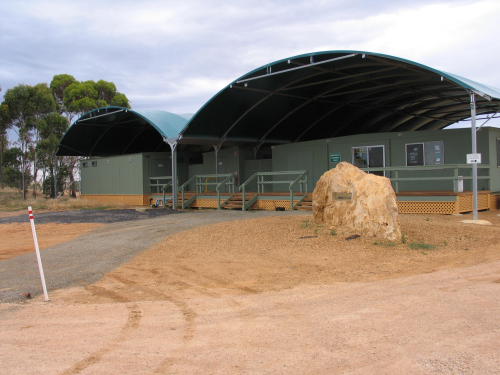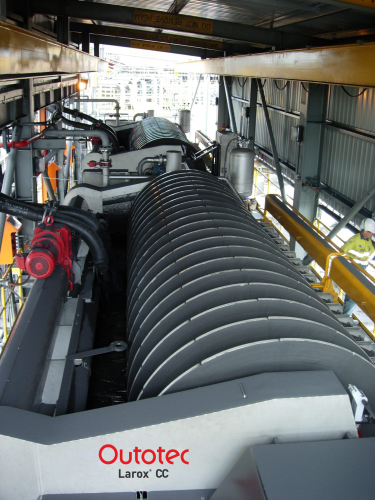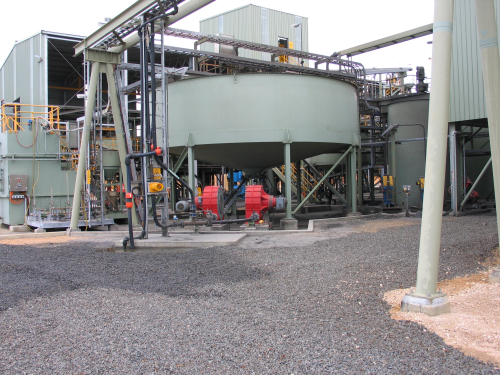


In 2008/9 the Angas mine in South Australia was outperforming its metal recovery targets and mining grades were expected to reach a projected 400,000 tonnes per annum of concentrate for the life of mine. Full production capacity for the new lead-zinc mine was brought forward by six months to January 2009. Aided by a lean start-up and lower consumable costs for grinding, milling reagents, diesel, as well as lower costs for smelting and shipping, the mine’s site operating cash costs for 2009 were revised downwards, despite a weaker Australian dollar. The Angas zinc mine is one of Terramin Australia Pty Ltd’s base metal projects selected for its high grade ore, proximity to infrastructure such as ports, roads, water and power, and its potential for expansion. Sempra Metals and Concentrates Corporation holds a life-of-mine off take for Angas’ concentrate, forecast to be 60,000 tonnes per annum for zinc and 22,000 tonnes per annum for lead.
Challenges for dewatering
In its first year of life, the low-cost mine with a resource of 2.4 million tonnes and situated only 60 kilometres (i.e. 45 minutes) from Adelaide, had produced nearly 23,000 tonnes of high-grade lead and zinc concentrate by the end of its second quarter. The transport of lead and zinc concentrate commenced shortly after the mine’s commissioning in July 2008. Lead concentrate was trucked to Port Pirie’s smelter while zinc concentrate was delivered to Port Adelaide before shipping to Korea. Stringent mine and rehabilitation plan conditions for the Angas mine were in place to help reduce the potential impact on the nearby local development of Strathalbyn. Noise levels could not exceed 47 dB by day and 40 dB by night. Groundwater contamination was minimised by the containment of processing waste in a state-of-the-art tailings storage facility, valued at A$7.5 million with double-lined high density polyethylene (HDPE) and was sized for mine expansion.
Dewatering with Outotec Larox CC
The South Australian Centre for Economic Studies predicted that Angas’ initial seven-year mine life had future expansion possibilities, and would boost the local economy by A$29 million per annum. The mine’s start-up performance far exceeded expectations and was due in part to an advanced filtering and drying system for the two concentrates, supplied and installed by Outotec. Angas installed two Outotec Larox CC filters, fed by two Flowrox peristaltic roller compressing pumps, to meet its dewatering needs. While sized for expansion and variable production rates, the two Outotec Larox CC filter systems use capillary action within ceramic disks to dewater the lead and zinc concentrates. The extracted filtrates are very high in clarity while the dried filter cakes met required transport moisture limits (TMLs) for their ore grades.
Outotec pumps in operation
The Flowrox feed pumps employ a single, bearing-mounted roller design that compresses each hose once during a 360 degree operating cycle. This feature reduces the hose compressions required by 50% when compared to traditional peristaltic pumps that use two sliding shoes. After slurry thickening, the Flowrox pumps feed the relatively coarse lead (P80, 50μm) and zinc (P80, 71μm) concentrates into their respective filtering system. Here concentrates coat the ceramic disk segments during immersion in slurry baths and dewatering starts immediately via capillary action. Extracted filtrate passes through microporous holes in each disk before being transferred away by a small 2.2 kW vacuum pump. The dried filter cake that remains is continuously scraped off, as the disks rotate.
Ceramec capillary action disc filter
Outotec has undertaken extensive work to develop its Outotec Larox CC filters as top performers in the global mineral, metallurgical and mining markets. One of the latest Outotec Larox CC filters, with new ultrasonic positioning between the discs, is being used by Angas at rates of 75-90% over a 24-hour period, depending on the ore grade being received. Angas initially planned to install Outotec Larox PF pressure filters instead of Outotec Larox CC filters after it experienced optimisation issues with an earlier version of Ceramec filters at Broken Hill in 1985. Once convinced by extensive tests and other site successes that the latest Outotec Larox CC filter would be ideal for the site, Angas installed a Outotec Larox CC disc filter model CC30 (i.e. 30 m² filter area) for the zinc and model CC6/15 (i.e. 6 m² filter area; expandable to 15 m²) for the lead.
Maximising benefits
When lead grades rose higher than expected soon after installation, Outotec suggested to Angas a filter upgrade from the CC6/15 to a CC9/15 would provide the greatest economical expansion benefit. The extra disc, now installed, is providing Angas with a 30% increase in filtration capacity, allowing for the handling of higher lead when the ore grade is high. As a result of this upgrade, the lead filter can capably handle higher lead head grade and increase production while still producing filter cake under the required TML. Angas reports that it is pleased with the ongoing performance of the dewatering system. The mine is a good one that is professionally set out and producing on its investment because things are done right. So much so in fact, that the Algerian government is interested in what Angas mine is doing for Terramin’s development of its large Tala Hamza zinc deposit in Algeria.
Performance for life
Outotec says that the benefits of using Ceramec filters are being realised at Angas mine as well as other sites. The benefits include: • a plug-and-play design, • no downturn is required for maintaining filter discs, • maintenance checks are only needed for filter ultrasonics and seals once a month, • routine filter backwashing is automatic and takes only half an hour per shift, • feed pump hose leaks can be easily detected, • revolution counters can record pump hose life (thereby reducing unscheduled stoppages), and • processing noise levels can be kept to a minimum. Case study courtesy of Outotec.




